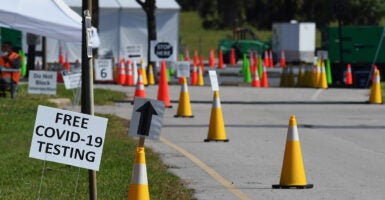Another new test for COVID-19 was recently authorized—and this one could be a game-changer.
The Abbott Diagnostics BinaxNOW antigen test is a new point-of-care test that reportedly costs only $5 to administer, delivers results in as little as 15 minutes, and requires no laboratory equipment to perform. That means it can be used in clinics far from commercial labs or without relying on a nearby hospital lab.
That last factor is key. There are other quick COVID-19 tests on the market, but they have all required lab equipment that can be expensive to maintain and operate, and costs can be prohibitive in places that need tests most.
This kind of test is reminiscent of rapid flu tests that are ubiquitous in clinics. They’ll give providers tremendous flexibility in testing for the disease in not just clinics, but with trained and licensed medical professionals, in schools, workplaces, camps, or any other number of places.
With other kinds of tests taking sometimes days to produce results, thanks to supply chain bottlenecks in parts of the country, innovations like this may be an important part of ensuring everyone who needs a test can get one—fast.
So what’s new about this test? Most of the current tests detect viral RNA, the genetic material of SARS-CoV-2. This is a very accurate way of detecting the virus, but it requires lab equipment to break apart the virus and amplify the amount of genetic material to high enough levels for detection. The BinaxNOW test detects antigens—proteins unique to the virus that are usually detectable whenever there is an active infection.
There are a small number of other tests on the market that also detect viral antigens rather than viral RNA. But like the RNA tests, they also require using proprietary equipment to read the results. This one only requires the test kit, which can be stored at room temperature, and a nasal swab that can be found in every clinic or medical facility.
Because this test is different from other COVID-19 tests, its production doesn’t require many of the extra supplies needed to make the test work—reagents or components—that are in high demand for the RNA-based tests. High demand for those test components have been a major cause of slow testing result turnaround times.
Abbott says it intends to produce 50 million tests per month starting in October. That’s far more than the number tested in July, when we were breaking new testing records on a daily basis with approximately 23 million tests recorded.
But even if these tests are produced in the promised numbers, whether they’ll help depends on how they are distributed and employed. There are some potential pitfalls with these tests.
The first issue is whether the test can be used at all by a clinic. While the technology is different (antigen versus RNA), they both require nasal swabs to collect a sample. Unfortunately, nasal swabs have frequently been in short supply in areas trying to conduct large numbers of tests.
The other issue is that, while this test allows an outlying clinic to easily test patients for COVID-19, no doctor’s office will schedule a patient with a suspected case of COVID-19 to walk into the waiting room to be tested.
As this disease is so infectious—approximately four times more infectious than H1N1 influenza—clinics will almost certainly require special protocols for COVID-19 testing. If a clinic is unable to accommodate suspected cases of COVID-19, it’ll likely direct patients to local health department resources that are more likely to use RNA-based tests that need to be sent to commercial labs.
But those who use these tests, and future ones like it, now have the option to employ them in ways to best suit their needs.
Quick point-of-care tests, unbound by complex equipment, may become part of what the testing regime looks like when society shifts to catching new cases before outbreaks can occur. In the meantime, if Abbott is able to meet its production goals, it could greatly alleviate backlogs in testing.
The important thing is that this kind of innovation continues to happen. The Trump administration’s effort to clear out red tape is paying off. It’s leading to private industry doing what it does best—figuring out how to help us beat the pandemic through new tests and treatments.
Whether the BinaxNOW test is a game-changer or not remains to be seen, but the increasing number and variety of available tests is a welcome development working to wipe out COVID-19 in America.






























